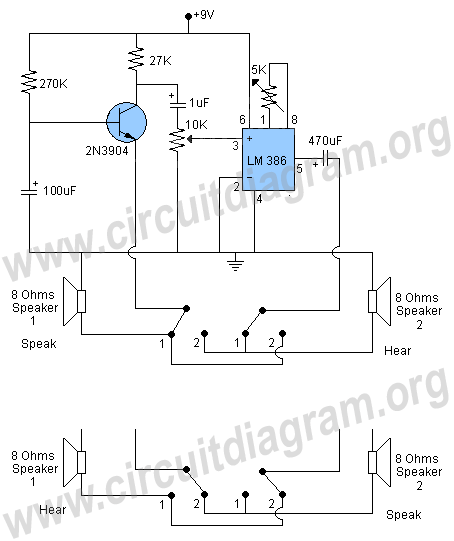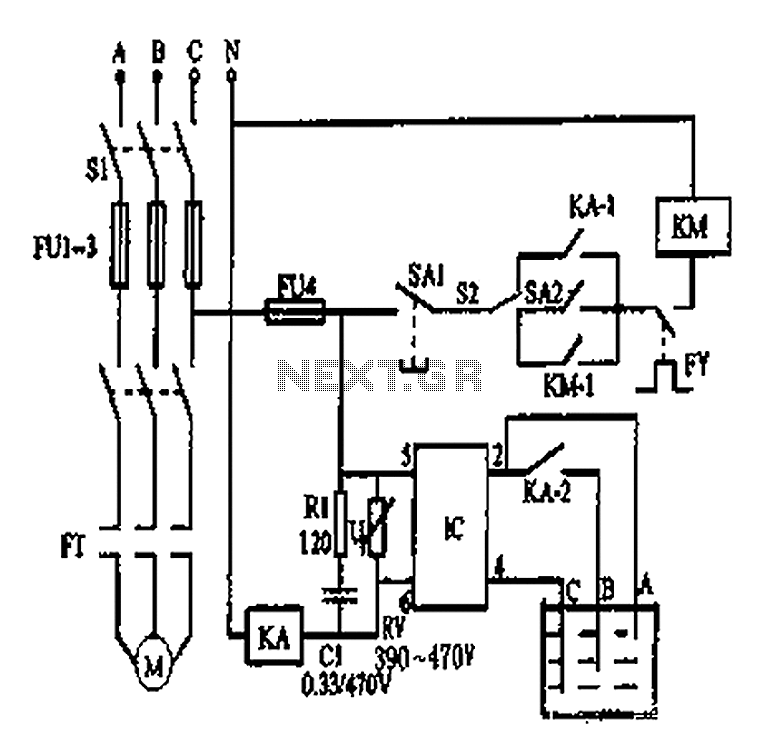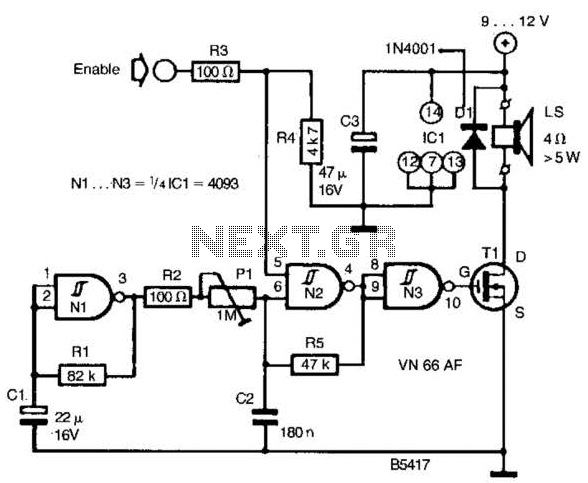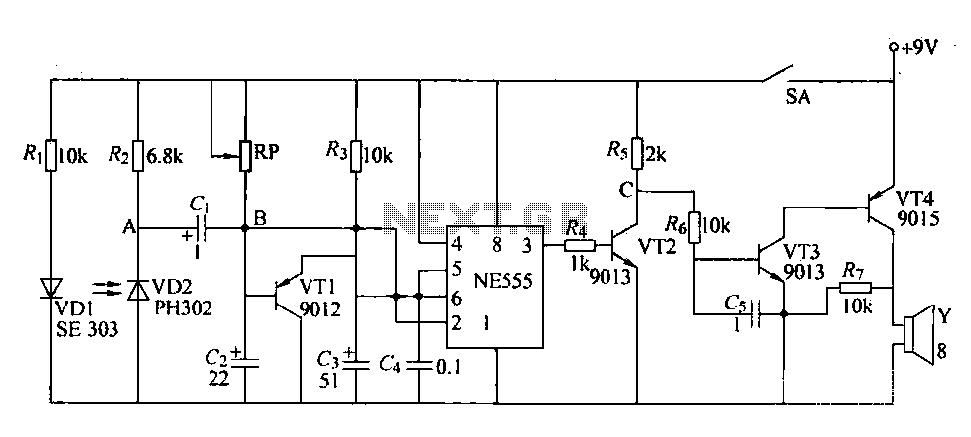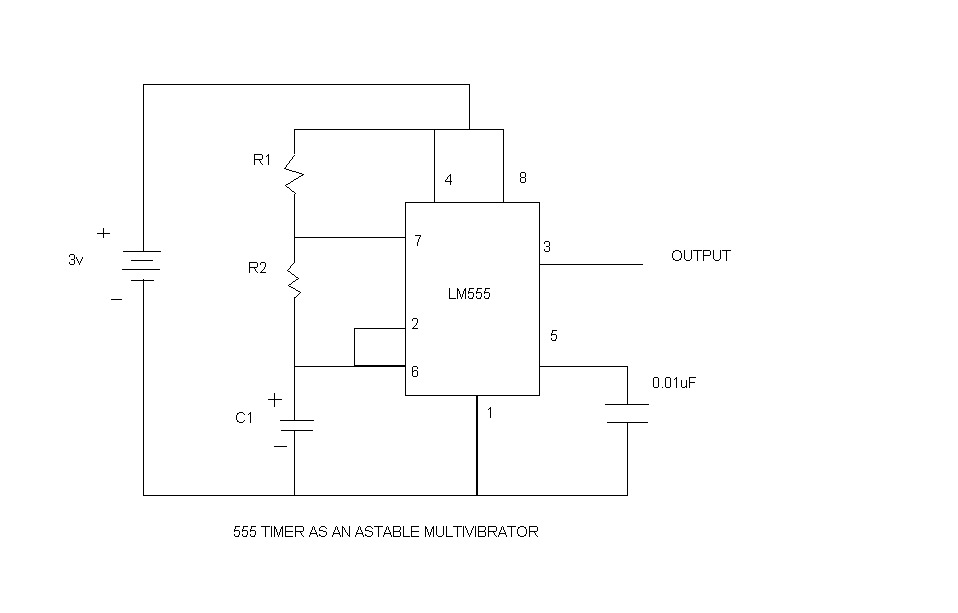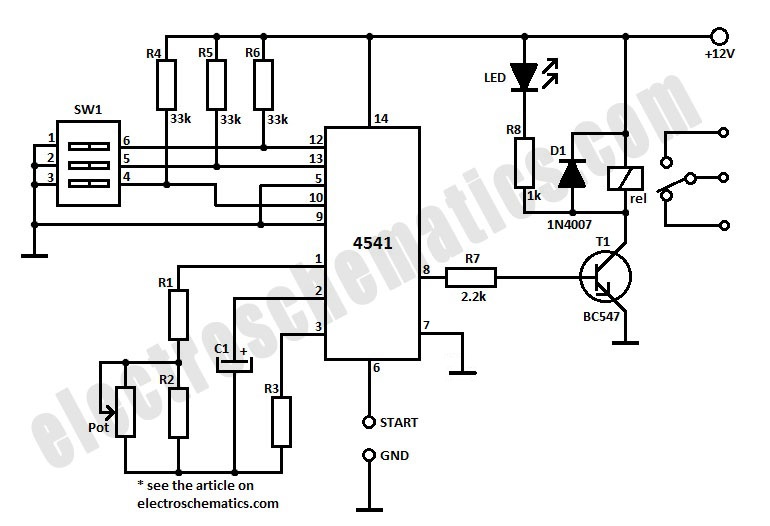
Long Delay Timer Circuit
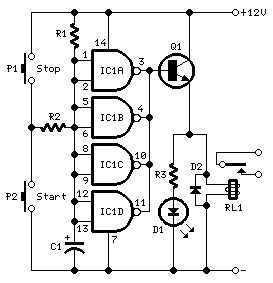
This timer is designed primarily to turn off a portable radio after a set duration. This feature allows users to relax on the beach or in a hammock, confident that the device will automatically power down after a specified period, thereby conserving battery life. Resistor R1 and capacitor C1 create a long time constant. When switch P2 is briefly closed, C1 discharges, resulting in a near-zero voltage at its positive lead, which is then applied to the high-impedance inputs of the four gates of integrated circuit IC1, configured in parallel. Consequently, the outputs of these gates transition to a high state, making battery voltage accessible at the emitter of transistor Q1. Once P2 is released, C1 begins to charge slowly through R1. When the voltage at the positive lead of C1 reaches approximately half of the battery voltage, the outputs of the IC gates drop to zero, which turns off Q1. This transistor can directly drive a portable radio receiver or other devices that draw up to about 250 mA. By connecting a relay across the emitter of Q1 and the negative ground, devices that require higher voltage and current can be controlled through the relay's contacts. Pressing P2 for 1 to 5 seconds activates the circuit, which will then turn off after approximately 35 minutes. The time delay can be adjusted by modifying the values of R1 and/or C1. Additionally, potentiometer P1 can be used to halt the timer if necessary.
The timer circuit is a practical solution for users who wish to enjoy audio entertainment without the worry of draining the battery. The circuit operates based on a simple RC (resistor-capacitor) timing mechanism, where R1 controls the charge time of capacitor C1. The choice of values for R1 and C1 is crucial, as they determine the overall time delay before the circuit switches off. A longer resistance or capacitance will yield a longer delay, allowing for customization based on user preference.
IC1, typically a CMOS logic gate IC, is used for its low power consumption and high input impedance, which is suitable for battery-operated devices. The parallel configuration of the gates ensures that the signal is amplified, allowing for reliable operation even with minimal voltage levels from C1. Transistor Q1 serves as a switch that can handle a moderate load, making it ideal for directly powering small devices like portable radios. For applications requiring more power, the relay adds versatility by enabling control of higher voltage devices while isolating the timer circuit from the load.
The activation mechanism through switch P2 is simple yet effective. The momentary closure of P2 initiates the discharge of C1, triggering the timer sequence. The gradual charging of C1, governed by R1, ensures that the timer operates smoothly without abrupt cut-offs. The addition of P1 allows users to manually stop the timer, providing an extra layer of control over the operation.
Overall, this timer circuit is an efficient and user-friendly solution for automatically powering down devices, enhancing battery life while providing convenience for users engaged in leisure activities.This timer was designed mainly to switch off a portable radio after some time: in this way, one can fall asleep on the sand or on a hammock, resting assured that the receiver will switch off automatically after some time, saving battery costs. R1 and C1 provide a very long time constant. When P2 is momentarily closed, C1 discharges and the near ze ro voltage at its positive lead is applied to the high impedance inputs of the four gates of IC1 wired in parallel. The four paralleled gate outputs of the IC go therefore to the high state and the battery voltage is available at Q1 Emitter.
When P2 is released, C1 starts charging slowly through R1 and when the voltage at its positive lead has reached about half the battery voltage, the IC gate outputs fall to zero, stopping Q1. This transistor can directly drive a portable radio receiver or different devices drawing a current up to about 250mA.
Connecting a Relay across the Emitter of Q1 and negative ground, devices requiring much higher voltage and current operation can be driven through its contacts. Pushing on P2 for 1 to 5 seconds, the circuit starts and then will switch off after about 35 minutes.
This time delay can be varied by changing R1 and/or C1 values. P1 will stop the timer if required. 🔗 External reference
The timer circuit is a practical solution for users who wish to enjoy audio entertainment without the worry of draining the battery. The circuit operates based on a simple RC (resistor-capacitor) timing mechanism, where R1 controls the charge time of capacitor C1. The choice of values for R1 and C1 is crucial, as they determine the overall time delay before the circuit switches off. A longer resistance or capacitance will yield a longer delay, allowing for customization based on user preference.
IC1, typically a CMOS logic gate IC, is used for its low power consumption and high input impedance, which is suitable for battery-operated devices. The parallel configuration of the gates ensures that the signal is amplified, allowing for reliable operation even with minimal voltage levels from C1. Transistor Q1 serves as a switch that can handle a moderate load, making it ideal for directly powering small devices like portable radios. For applications requiring more power, the relay adds versatility by enabling control of higher voltage devices while isolating the timer circuit from the load.
The activation mechanism through switch P2 is simple yet effective. The momentary closure of P2 initiates the discharge of C1, triggering the timer sequence. The gradual charging of C1, governed by R1, ensures that the timer operates smoothly without abrupt cut-offs. The addition of P1 allows users to manually stop the timer, providing an extra layer of control over the operation.
Overall, this timer circuit is an efficient and user-friendly solution for automatically powering down devices, enhancing battery life while providing convenience for users engaged in leisure activities.This timer was designed mainly to switch off a portable radio after some time: in this way, one can fall asleep on the sand or on a hammock, resting assured that the receiver will switch off automatically after some time, saving battery costs. R1 and C1 provide a very long time constant. When P2 is momentarily closed, C1 discharges and the near ze ro voltage at its positive lead is applied to the high impedance inputs of the four gates of IC1 wired in parallel. The four paralleled gate outputs of the IC go therefore to the high state and the battery voltage is available at Q1 Emitter.
When P2 is released, C1 starts charging slowly through R1 and when the voltage at its positive lead has reached about half the battery voltage, the IC gate outputs fall to zero, stopping Q1. This transistor can directly drive a portable radio receiver or different devices drawing a current up to about 250mA.
Connecting a Relay across the Emitter of Q1 and negative ground, devices requiring much higher voltage and current operation can be driven through its contacts. Pushing on P2 for 1 to 5 seconds, the circuit starts and then will switch off after about 35 minutes.
This time delay can be varied by changing R1 and/or C1 values. P1 will stop the timer if required. 🔗 External reference
